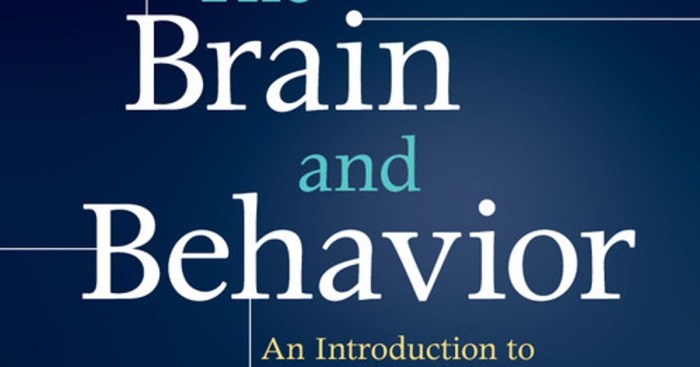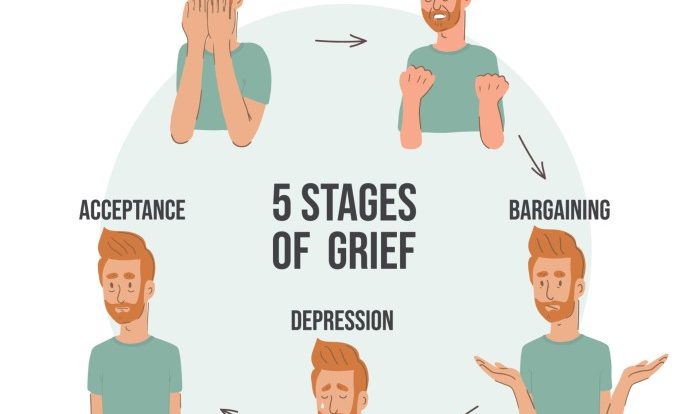Introduction to brain and behavior 7th edition – In the realm of psychology and neuroscience, the “Introduction to Brain and Behavior, 7th Edition” emerges as a comprehensive guide that unravels the intricate relationship between the brain and behavior. This seminal work delves into the historical foundations, cutting-edge methodologies, and groundbreaking discoveries that have shaped our understanding of the human mind and its complexities.
Through the pages of this esteemed text, readers will embark on a captivating journey into the inner workings of the nervous system, exploring the structure and function of neurons, the mechanisms underlying sensory perception, and the neural basis of cognitive processes.
The authors present a multifaceted perspective, encompassing cellular and molecular neuroscience, developmental neuroscience, and clinical neuroscience, providing a holistic understanding of the brain and its influence on our thoughts, emotions, and actions.
Historical Foundations of Neuroscience

Neuroscience, the scientific study of the brain and behavior, has a rich and multifaceted history. Its origins can be traced back to ancient Egypt, where hieroglyphs depicted the brain as the seat of intelligence and emotions. In the 4th century BC, the Greek philosopher Aristotle conducted pioneering studies on the anatomy and function of the nervous system.
During the Renaissance, Leonardo da Vinci’s anatomical drawings provided detailed insights into the structure of the brain. In the 17th century, René Descartes proposed the concept of dualism, which suggested that the mind and body were separate entities. This idea influenced neuroscience for centuries.
Key Historical Figures
- Hippocrates (460-377 BC):Considered the “Father of Medicine,” Hippocrates believed that the brain was the center of thought and emotion.
- Galen (129-216 AD):A Greek physician who made significant contributions to anatomy and physiology, including the study of the nervous system.
- Andreas Vesalius (1514-1564):A Flemish anatomist who published detailed illustrations of the human body, including the brain.
- Santiago Ramón y Cajal (1852-1934):A Spanish histologist who pioneered the use of staining techniques to study the structure of neurons.
- Charles Darwin (1809-1882):His theory of evolution by natural selection had a profound impact on neuroscience, suggesting that the brain and behavior had evolved over time.
Methods in Neuroscience

Neuroscientists employ a wide range of techniques to study the brain and behavior, each with its own strengths and limitations.
Neuroimaging Techniques, Introduction to brain and behavior 7th edition
- Magnetic Resonance Imaging (MRI):Uses magnetic fields and radio waves to produce detailed images of the brain’s structure and function.
- Functional Magnetic Resonance Imaging (fMRI):Measures changes in blood flow in the brain, indicating areas of activity during cognitive tasks.
- Electroencephalography (EEG):Records electrical activity on the scalp, providing insights into brain rhythms and cognitive processes.
- Magnetoencephalography (MEG):Measures magnetic fields produced by electrical activity in the brain, providing high temporal resolution.
Electrophysiological Techniques
- Electrode Recordings:Involves inserting electrodes into the brain or nervous system to record electrical signals from neurons.
- Patch-Clamp Technique:Records electrical currents flowing through ion channels in neuron membranes.
- Transcranial Magnetic Stimulation (TMS):Uses magnetic pulses to stimulate or inhibit brain regions, assessing their role in behavior.
Behavioral Observation Techniques
- Observational Studies:Researchers observe animals or humans in their natural environments to study behavior.
- Controlled Experiments:Researchers manipulate variables in controlled settings to determine cause-and-effect relationships in behavior.
- Animal Models:Animal studies provide insights into brain function and behavior, as well as the effects of drugs and treatments.
Cellular and Molecular Neuroscience: Introduction To Brain And Behavior 7th Edition
Cellular and molecular neuroscience focuses on the structure and function of neurons and other cells in the nervous system.
Neurons
Neurons are the basic units of the nervous system. They are specialized cells that transmit electrical and chemical signals to communicate with each other.
Neuron Structure
- Cell Body (Soma):Contains the nucleus and other organelles.
- Dendrites:Branching extensions that receive signals from other neurons.
- Axon:A long, slender extension that transmits signals to other neurons.
- Synapse:Junction where neurons communicate through neurotransmitters.
Molecular Mechanisms
- Neurotransmitters:Chemical messengers that transmit signals across synapses.
- Ion Channels:Proteins that allow ions to flow across neuron membranes, generating electrical signals.
- Receptors:Proteins that bind to neurotransmitters and trigger cellular responses.
- Plasticity:The ability of neurons to change their structure and function in response to experience.
FAQ Compilation
What is the main focus of “Introduction to Brain and Behavior, 7th Edition”?
The primary focus of this text is to provide a comprehensive understanding of the relationship between the brain and behavior, encompassing historical foundations, methodologies, and the latest research in neuroscience and psychology.
Who is the intended audience for this book?
This book is designed for students, researchers, and professionals in the fields of psychology, neuroscience, and related disciplines who seek a comprehensive and up-to-date overview of the brain and behavior.
What are the key strengths of this text?
The key strengths of this text include its comprehensiveness, clarity, and integration of cutting-edge research. It provides a balanced perspective, covering both the biological and psychological aspects of brain and behavior.
